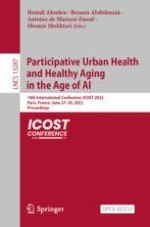Open Access 2022 | Open Access | Book

Participative Urban Health and Healthy Aging in the Age of AI
19th International Conference, ICOST 2022, Paris, France, June 27–30, 2022, Proceedings
Editors: Hamdi Aloulou, Prof. Bessam Abdulrazak, Antoine de Marassé-Enouf, Mounir Mokhtari
Publisher: Springer International Publishing
Book Series : Lecture Notes in Computer Science